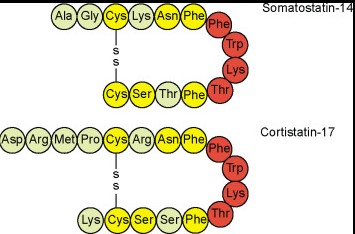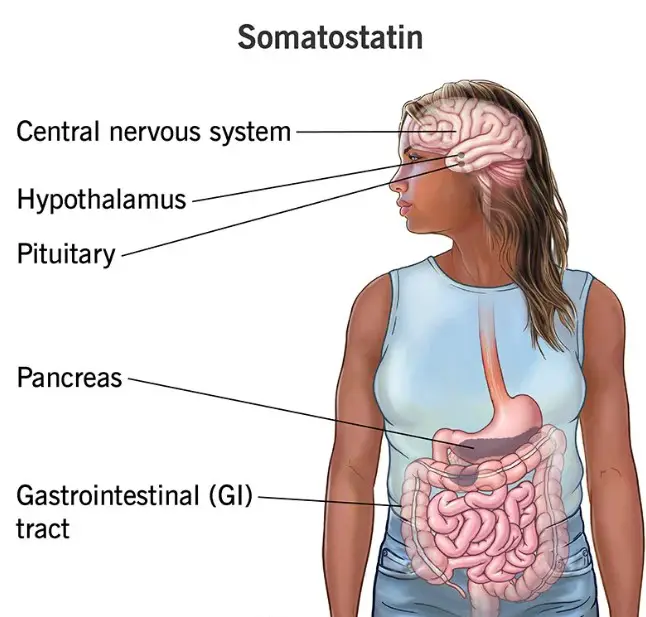Hormones are the unsung heroes of our bodily functions, orchestrating a wide array of physiological activities from growth to metabolism. Among these, Somatostatin and Somatotropin stand out due to their pivotal roles in regulating growth and bodily functions. These hormones, despite their similar-sounding names, play contrasting roles in the human body.
Somatostatin, also known as growth hormone-inhibiting hormone (GHIH), acts as a regulator by inhibiting the release of several other hormones, including Somatotropin, which is also known as growth hormone (GH). Somatotropin, on the other hand, stimulates growth, cell reproduction, and cell regeneration in humans and other animals. Thus, while Somatostatin acts as a brake, Somatotropin functions as a gas pedal in the endocrine system of the body.
The dynamic between Somatostatin and Somatotropin is a classic example of the body’s checks and balances. Somatostatin ensures that growth and other hormonal activities do not exceed safe limits, while Somatotropin promotes growth and regeneration, essential for development and healing. Understanding these hormones’ functions and interactions provides crucial insights into health, disease management, and therapeutic possibilities.

Hormone Basics
Hormonal Functions
Hormones are chemical messengers produced by the endocrine glands in the body. They travel through the bloodstream to tissues or organs, orchestrating multiple bodily functions such as growth, metabolism, and reproduction. Essentially, hormones work as the body’s communication system, coordinating complex processes across different systems seamlessly.
Hormonal Production
Hormones are synthesized and secreted by various glands and tissues, including the pituitary gland, thyroid gland, adrenals, and pancreas. The production of hormones is a finely tuned process, regulated by feedback mechanisms. For instance, the production of a particular hormone can be increased or decreased in response to the body’s needs, ensuring a balanced internal environment, a state known as homeostasis.
Somatostatin
Overview
Somatostatin, also termed growth hormone-inhibiting hormone (GHIH), is a peptide hormone that plays a pivotal role in inhibiting the release of other hormones. It acts as a regulator within the endocrine system, ensuring that the production and release of certain hormones are kept in check.
Production Sites
Somatostatin is produced in several parts of the body, notably within the hypothalamus (a part of the brain that regulates physiological processes), the pancreas, and the digestive tract. Each of these production sites allows Somatostatin to exert its effects locally and systemically, influencing a wide range of bodily functions.
Key Functions
The roles and effects of Somatostatin are diverse:
- Inhibits the release of growth hormone (GH), directly impacting growth and development processes.
- Regulates the endocrine system by inhibiting the secretion of hormones such as thyroid-stimulating hormone (TSH) and adrenocorticotropic hormone (ACTH).
- Controls the digestive system by suppressing the secretion of various gastrointestinal hormones, slowing down gastric emptying, and reducing blood flow within the intestine.
Mechanism of Action
At the cellular level, Somatostatin works by binding to its receptors on the surface of target cells, activating intracellular signaling pathways that lead to a decrease in hormone secretion. This inhibition can occur through several mechanisms, including reducing the influx of calcium ions, which are essential for hormone release.
Somatotropin
Overview
Somatotropin, commonly known as growth hormone (GH), is a protein hormone that stimulates growth, cell reproduction, and regeneration. It plays a key role in physical development and maintains various bodily functions throughout life.
Production Sites
The anterior pituitary gland is the primary site of Somatotropin production. This gland, located at the base of the brain, releases Somatotropin into the bloodstream, where it travels to target tissues, exerting its wide-ranging effects.
Key Functions
Somatotropin’s impact on the body is profound:
- Stimulates growth in bones and muscles, crucial during childhood and adolescence.
- Enhances protein synthesis and increases fat breakdown, contributing to muscle mass and energy levels.
- Regulates blood sugar levels by reducing insulin sensitivity, ensuring a stable supply of glucose for the body’s needs.
Mechanism of Action
Somatotropin operates through direct and indirect mechanisms. Directly, it binds to receptors on target cells, such as muscle, fat, and bone cells, initiating growth and metabolic processes. Indirectly, it stimulates the liver and other tissues to produce insulin-like growth factor 1 (IGF-1), a hormone that promotes growth and development.

Comparative Analysis
Chemical Structure
The chemical structures of Somatostatin and Somatotropin showcase their distinct nature and functions. Somatostatin is a peptide hormone composed of two active forms: one with 14 amino acids and another with 28 amino acids. This peptide structure allows it to easily bind to its receptors and inhibit hormone release. On the other hand, Somatotropin is a protein hormone, larger than Somatostatin, consisting of 191 amino acids. Its complex structure enables it to interact with growth hormone receptors, stimulating growth and metabolism.
Biological Effects
The biological effects of these two hormones in the body are fundamentally different. Somatostatin acts primarily as an inhibitor, preventing the release of growth hormone and other hormones, thereby controlling growth and reducing metabolic activities. Conversely, Somatotropin promotes tissue growth, increases protein synthesis, and enhances lipid metabolism. It stimulates growth in almost all tissues of the body, including bone and muscle, making it crucial for developmental growth.
Interactions and Balance
The interaction between Somatostatin and Somatotropin is a perfect example of the body’s regulatory balance. Somatostatin inhibits the release of Somatotropin from the pituitary gland when the levels of growth hormone are too high or when certain physiological conditions, such as high blood sugar levels, are met. This feedback loop ensures that growth processes are not overstimulated, maintaining homeostasis and preventing disorders associated with excessive or insufficient growth hormone levels.
Clinical Significance
The clinical significance of understanding Somatostatin and Somatotropin cannot be overstated. Abnormal levels of either hormone can lead to a variety of health issues. For example, excessive production of Somatotropin can cause conditions like gigantism or acromegaly, while insufficient levels can lead to growth hormone deficiency. Somatostatin’s ability to inhibit various hormones makes it pivotal in treatments for conditions associated with hormone overproduction.
Therapeutic Uses
Somatostatin Applications
Somatostatin has found its niche in medical treatments due to its inhibitory effects on hormone release. Its applications include:
- Acromegaly Treatment: Used to control excess growth hormone production.
- Gastrointestinal Disorders: Effective in treating conditions like variceal bleeding, pancreatic fistulas, and acute pancreatitis due to its ability to suppress the secretion of gastrointestinal and pancreatic fluids.
- Tumor Suppression: Administered to manage hormone-secreting tumors such as neuroendocrine tumors, thereby controlling symptoms associated with hormone overproduction.
Somatotropin Applications
Somatotropin’s role in stimulating growth and regeneration makes it invaluable in treating various conditions, including:
- Growth Hormone Deficiency (GHD): In both children and adults, synthetic growth hormone is used to treat GHD, promoting normal growth and development.
- Turner Syndrome: Administered to girls with Turner Syndrome to promote growth and reach a more typical height.
- Chronic Kidney Disease (CKD): Helps children with growth failure due to CKD achieve a more typical growth rate.
- Muscle Wasting Diseases: Used to maintain muscle mass in diseases such as HIV/AIDS.
The applications of Somatostatin and Somatotropin in medicine are a testament to their vital roles in human health. By leveraging their biological effects, medical professionals can treat a range of conditions, improving patients’ quality of life and health outcomes.
Frequently Asked Questions
What triggers Somatostatin release?
Somatostatin release is triggered by several factors, including high levels of growth hormone (GH) in the blood, hyperglycemia, and the presence of amino acids in the stomach. Its release is part of the body’s feedback mechanism to regulate the endocrine system’s activity, ensuring that the balance of hormones remains within healthy limits.
How does Somatotropin affect the body?
Somatotropin, or growth hormone, has profound effects on the body, including stimulating growth in bones and muscles, regulating metabolism, and promoting cell regeneration and repair. Its actions are critical during childhood and adolescence for growth spurts but continue to play important roles in maintaining muscle mass, bone density, and tissue health in adults.
Can Somatostatin and Somatotropin levels be modified?
Yes, the levels of Somatostatin and Somatotropin can be modified through medical interventions. For instance, synthetic versions of Somatostatin can be administered to manage conditions such as acromegaly, while synthetic Somatotropin is used in treating growth hormone deficiency. Both hormones can also be affected by lifestyle factors, including diet, exercise, and stress levels.
What are the medical uses of Somatostatin and Somatotropin?
Somatostatin has medical uses in treating conditions like acromegaly, certain types of tumors, and severe diarrhea associated with specific conditions. Somatotropin is used in treating growth hormone deficiency in children and adults, aiding in growth and maintaining proper body composition, bone density, and muscle mass.
Conclusion
The interplay between Somatostatin and Somatotropin illustrates the complexity and balance of the human endocrine system. Their contrasting yet complementary roles underscore the body’s ability to regulate itself, maintaining a delicate equilibrium between growth and inhibition. Understanding these hormones not only sheds light on basic biological processes but also paves the way for therapeutic interventions in a variety of growth-related conditions.
In closing, the intricate dance between Somatostatin and Somatotropin highlights the importance of hormonal balance in overall health. This balance is crucial for normal growth, metabolism, and tissue repair, demonstrating the significance of each hormone in our body’s symphony of biochemical reactions. Their study and manipulation continue to offer promising avenues for treating a range of medical conditions, further emphasizing their pivotal role in medicine and health sciences.

